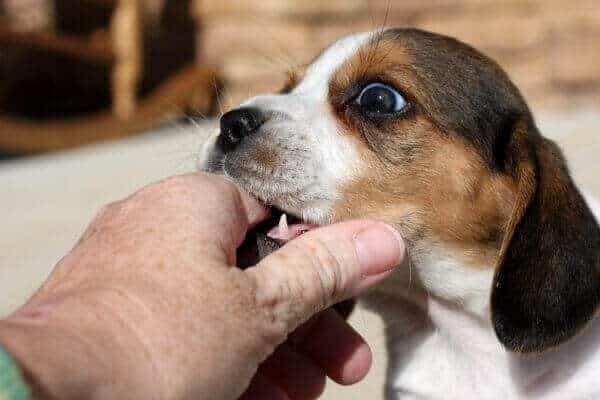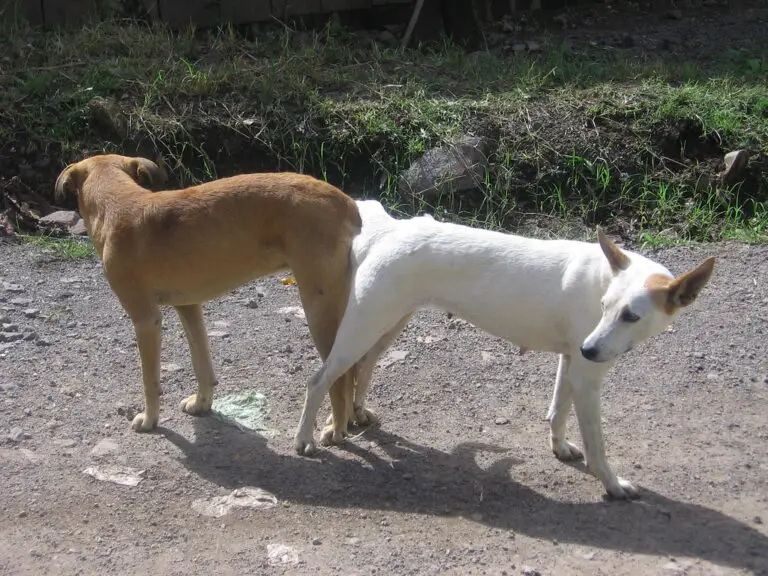Can A 1 Or 2 Month Old Puppy Bite Cause Rabies? (Understanding The Risks)

Rabies, a fatal viral infection affecting all mammals, is primarily transmitted through saliva. It remains dormant outside the body and becomes active in the mammalian bloodstream, targeting the brain and spinal cord. This virus is responsible for approximately 59,000 human fatalities annually.
Having a rabid dog at home is scary, but what is more threatening is that you may be living with a small pup that seems to be perfectly fine, but unfortunately, you are not aware that he has been infected with rabies because most of the people believe that young puppies cannot get rabies.
Contrary to common belief, puppies as young as 1 or 2 months can transmit rabies. This transmission occurs through saliva, often via bites, and is equally fatal in dogs and humans. While all dogs, regardless of age or breed, can spread rabies if infected, instances of transmission from very young puppies are rare but possible.
To put it simply, dogs of all ages and breeds can spread the rabies virus provided they are infected.
Can A 1 Month Old Puppy Bite Cause Rabies?
Most people ignore puppy bites because they think that the rabies virus doesn’t belong to young pups.
Be aware!! Your innocent pup can become potentially fatal to you if he/she comes in contact with a rabid or stray dog.
If you find a street dog is trying to bite your young pup, you should immediately reach the spot and if you find any bite injury on your puppy’s body, you have to take him to a vet for wound cleaning and vaccination.
Does a 2-Month Old Puppy Have Rabies?
A young 2-month-old pup can easily become infected by rabies itself by the bite of another rabid canine or animal, during a fun playfight or a moment of uncontrolled aggression.
If the infected puppy bites a human, this deadly virus can enter the bloodstream.
Apart from biting, the rabies virus can also be transmitted if dogs lick the wounds or scratches of other dogs.
Are Puppy Bites Harmful?

Causally, Gentle puppy bites are not considered to be harmful and most people believe that biting and nipping is a casual or natural behavior of puppies during teething or playtime.
Remember!! puppies don’t bite without any reason.
Hard bites that tear the skin and draw out blood are considered to be harmful. Sometimes puppies may become overexcited or feel threatened and unsafe from their surroundings, as a result, they can give you a deep painful bite.
What Happens If A Puppy Bites You?
A puppy bite may result in injuries like puncture wounds, scarring, and nerve and muscle damage.
If you notice some symptoms like fever, pus, swelling, redness, or regular pain then you have to visit a doctor.
A puppy’s mouth is full of bacteria and viruses which he can transfer into the human body just through a single intense bite and leaves deadly infections in human beings.
Rabies is the most common but fatal viral infection, while Tetanus, Staph & Strep, Capnocytophaga, and Pasteurella are typical bacterial infections caused by dog bites.
What Should You Do If A Puppy Bites You?
If a puppy, regardless of its age, bites you, immediate action is necessary. Clean the wound thoroughly and seek medical attention, especially if the puppy’s rabies vaccination status is unknown. Remember, while playful puppy bites are common, a bite breaking the skin poses a risk of rabies transmission.
- Wash the wound site immediately with lukewarm water and soap to remove any pathogen, hair, or teeth.
- If your wound is deep and bleeding, then after washing use a towel and press gently to stop it.
- You can apply topical ointments and cover them with an antiseptic bandage to prevent infections on the wound site.
- If blood doesn’t stop and you are in continuous pain, then you should visit your doctor for a proper check-up.
Do Puppies Have Rabies?
Dogs are not the only creatures that are responsible for transmitting rabies to each other.
A dog can get rabies from other animals as well like cats, bats, raccoons, coyotes, skunks, groundhogs, mongoose, foxes, etc, so have a keen eye on your canine when you go outside for a walk.
How do dogs get rabies?
The most typical way of getting rabies in dogs is by the bite of another rabid animal.
However, Biting is not the only source of transmitting this virus. Dogs can also get this virus through a scratch or by licking other rabid animals, though transmission through these routes is less common.
Your pooch is at risk of rabies if a rabid animal licks the open wounds or licks the nose, eyes, and mouth of a healthy dog.
Rabies is capable of getting into the brain through peripheral nerves in a process known as neurotropism. Hence, the virus is also present in the cerebrospinal fluids of dogs although they are rarely ever transmitted through this bodily fluid.
How Do You Know If A Dog Has Rabies (symptoms)
Recognizing early signs of rabies in puppies is crucial. These include lethargy, photophobia, and loss of appetite. There is no effective treatment for rabies once symptoms appear, so immediate veterinary care for bitten puppies is critical. Vaccinations play a pivotal role in preventing rabies in dogs.
A study shows that the rabies virus is not transmissible immediately when it enters in dog’s blood and does not show any symptoms at this stage, because the virus has not yet reached the saliva.
If your pooch is not vaccinated, then conditions may become lethal, when it enters the brain and spinal cord via nerves, where it multiples, causing brain inflammation, and reaches salivary glands and then finally, the saliva. Here are the various symptoms that occur in three stages: prodromal, excitative/furious, and then paralytic/dumb stages of rabies
Prodromal Stage
Normally, early symptoms may appear within 3-4 days after entering the brain which include fever, chills, vomiting, muscle pain, cough, diarrhea, etc and most dog owners may ignore them. Some rare early symptoms are as follows:
Malaise
It is a condition of extreme fatigue and laziness. If you feel your dog is suddenly feeling sick and become lethargic, even if he doesn’t want to get up from his bed.
If he is giving slow reactions and lacks interest in play and daily life activities, then your suspicion of rabies is not wrong.
Photophobia
As rabies attacks the brain so this virus sometimes may travel towards optic nerves and damage the retina of the eyes.
Dogs suffering from photophobia may develop a fear of light and any bright area may irritate them, so they prefer to hide in darker corners of the house, in more severe cases they may become blind.
Decreased Appetite
A decrease or loss of appetite is another early symptom of rabid dogs. In anorexia, the dog is still able to eat and does not experience any difficulty swallowing but just shows less desire to eat.
Furious Rabies
This is the most excitative stage of rabies in dogs and can last for up to one week. Common symptoms of dumb rabies may include:
Difficulty In Swallowing
When the furious rabies sets in your dog may develop what is presumed to the hydrophobia. However, dogs do not experience hydrophobia like humans, they only experience difficulty in swallowing food or water. Hence, this behavior is often misinterpreted as hydrophobia.
Aggressiveness
A rabid dog becomes unusually aggressive and he may attempt to bite, show his teeth, bark, or react violently to the people or animals that live around him.
If you observe this strange behavior of any dog you should call the animal control center.
Abnormal Behavior
After exposure to rabies, most of the dogs show awkward behaviors. They began to eat rocks, litter, and other non-edible things.
They may also start hallucinating, barking, growling, and moaning at non-existent items. Some of the dogs may begin to bite the air and behave threatened for no apparent reason.
Dumb Rabies
Dumb or paralytic may appear after 4-8 days and can last from weeks to months.
During this stage, the infection begins to spread to the other parts of the body and the symptoms become more obvious and extreme.
At this stage, your dog is no longer aggressive and doesn’t try to bite you. Some of the dumb rabies symptoms are discussed below:
Paralysis
As the virus grows, it attacks the hind legs first and then damages the forelegs, resulting in difficult mobility and ultimately complete loss of movement.
In other cases, a virus may attack facial muscles which damage the facial nerves resulting in facial paralysis in dogs. Hence, the reason why the affected canine is unable to eat or drink in this stage.
Excessive Drooling With Foam
Due to facial paralysis, your pooch began to dribble, and continuously, saliva falls like a thin stream with thick foam around his mouth.
Drooling does not present as just normal salvation, so this may be a very clear and potential sign that your dog is under the attack of rabies virus.
Is There Any Effective Treatment For Rabies In Dogs?
There are only a handful of cases where canines survive rabies after the onset of symptoms. However, some precautions can be taken at a very early stage.
If you notice your dog is being bitten by any other wandered dog or animal, then you have to take your canine to the vet for quick inoculation against rabies.
After vaccination, you have to keep your dog in isolation for 10 -15 days and keep on observing your dog’s mental and physical health.
If he is not showing any signs of rabies, then he is absolutely fine.
Make sure that during quarantine your pooch does not escape and come in close contact with any other animal or human.
Also Read: What Happens If A 2-Month-Old Puppy Bites You? Is It Harmful?
When Is The Earliest Puppies Can Get Rabies Vaccine?
Can Anti Rabies Be Taken By For 1 Or 2-Month-Old Puppy?
It is considered that a 1-month-old puppy can get sufficient antibodies and immunity from her mother’s milk to fight against diseases and he/she doesn’t need any rabies shots.
On the other hand, a 2-month-old puppy can get rabies shots, because the vet recommends they should be taken after 6 weeks and onwards. At this age, most puppies have been weaned off and the maternal immunity is cut short making the puppy more susceptible to infections.
In essence, it is ok to give rabies vaccination to your puppy as early as 2 months of age.
Do All Unvaccinated Dogs Have Rabies?
Not all unvaccinated dogs have rabies. When puppies are born they remain unvaccinated till the age of 2 months. It doesn’t mean he/she is carrying rabies as this disease is not inherited or inborn to canines.
Dogs and puppies can only get this infection from other animals with rabies.
But an unvaccinated dog is at a higher risk of getting a victim of this highly fatal infection.
If you want to save your beloved fido’s life, then it is important to play your part and follow a vaccination schedule against rabies which is recommended by your vet.
Why Do Puppies Bite A Lot?
It’s normal for pups to bite and chew almost everything their mouth can approach, as it is a natural behavior of canines. However, there can be several reasons behind this excessive biting.
Exploring the world: Puppies learn from biting, as this world is new to them and the only way to explore their surroundings is by biting and pawing.
Through biting they receive sensory information that how hard they can bite one particular object, and how it tastes, smells, and feels. Either they have to bite it again or not?
If a puppy like any object then he might bite it again and again.
Teething process: one of the main reasons behind excessive biting is their teething period.
Your puppy may be suffering from sore gums during teething, which is quite irritating for them and this uncomfortable duration may last from 2-3 months.
So, they want to bite and chew everything to overcome this frustration.
Playful behavior: normally young puppies are so playful and they want someone to stay engaged with them all the time.
During the fun time, they may bite you a lot called “play bite”, or if you offer those chewing toys, so they spend most of the time biting them.
Final Thoughts
In conclusion, while rabies is a serious concern, understanding the risks associated with puppy bites, especially in young dogs, is key to prevention. Always ensure your pets are vaccinated and seek prompt medical care for any animal bites to mitigate the risks of this deadly virus.
Rabies is an incurable viral infection of the nervous system. When a rabid canine bites you, this enters in blood and makes its way toward the brain and spinal cord and causes inflammation.
Just like adult dogs, small puppies are equally capable of spreading this pathogen. During cuddling or play, if a rabid puppy bites you, or leaves a scratch on your skin, this can be alarming for you. Sometimes they lick on open wounds introducing the rabies virus to your bloodstream.
There is no effective cure, clinically proven therapy, or test available for rabies after the onset of symptoms. Unfortunately, the best option will be to put down your pooch to prevent the infection of humans and other animals.
Read related posts about





